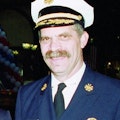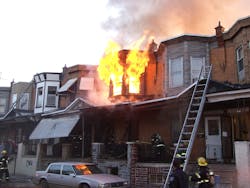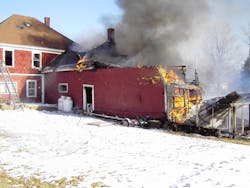Fire Studies: Structural Firefighting—The Offensive Attack
There are four basic modes of fire attack for structural firefighting: offensive, defensive, offensive/defensive and defensive/offensive. (The use of the nonintervention mode can be a consideration when encountering hazmat incidents.)
Fire has destroyed many structures as a result of a fire department hesitating to initiate a prompt attack on arrival. Implementing an offensive attack maximizes control efforts by allowing a quick attack on the fire. With an offensive attack, water is delivered to the seat of the fire, and rescues can be made under the protection of interior hoseline crews. A major part of the decision-making process is weighing the risk that is taken by the firefighters versus the gain to be achieved. High-risk situations with little or no gain must be avoided.
Decisions on the mode of attack must be made on arrival of the first-due company officer. Other questions to be decided include: What size hoseline is needed? Where should the first hoseline be placed? What about the second and third hoselines?
Offensive mode
Offensive attack means that hoselines are moved forward in an offensive manner, whether deployed through a window or door opening or from the interior of the structure. The initial incident commander at a dwelling fire must decide whether to initially make an offensive-exterior attack or offensive-interior attack.
The first hoseline must protect civilians who are exiting the building or in need of rescue. This hoseline should be placed between them and the fire. If the first hoseline is able to extinguish the fire, the rescue can be a simple task. If the amount of fire is too great for one hoseline, the first priority is to protect the trapped occupants and the firefighters who attempt to rescue them. If fire involves or threatens an open stairway, the same hoseline should be positioned to also protect the stairs or a second hoseline can be given this priority.
Gaining control of the stairs is the first step in gaining control of the building. Protected stairs can be used by firefighters to enter the structure and by civilians to leave it. Proper hoseline placement can reduce the heat of the fire extending via the stairs to the upper floors. While occupants are exiting a building, any ventilation needs to be limited, to ensure that oxygen that’s supplied to the fire won’t accelerate the blaze and draw the fire toward fleeing occupants. This might include door control of the fire room and at the point where the hoselines are stretched into the structure. (Door control at the entry point into a structure typically utilizes a firefighter to close the door onto the hoseline after it was stretched through a doorway. This restricts the inflow of air through that doorway). Firefighters who operate on the interior must coordinate with outside ventilation crews regarding what ventilation openings are needed and when to initiate those openings.
If an offensive-exterior attack is initiated, that hoseline or the second hoseline should be prepared to enter and attack the fire with an offensive-interior attack once the exterior knockdown of the fire is achieved. If the first hoseline initiated an interior attack, the second hoseline should back up the first hoseline. If fire involves more than one floor, the second hoseline can be placed on the floor above to control the fire there.
The third hoseline can be taken to protect any secondary exits. In my experience, a major loss of life in both single-family and multiple-occupancy dwelling units occurs in the rear of these properties. The third hoseline ensures that anyone who might be trapped initially and seeks escape via another exit will receive the protection of a hoseline.
The placement of the hoseline at this location must be monitored carefully, to assure that when hoselines are operating from different directions, they don’t oppose one another.
The rear of the fire building has the potential for rapid undetected fire spread and life safety considerations. A response to the rear must be ensured by at least one engine and one ladder or truck company to assist in rescues, laddering, ventilation and forcible entry. If a ladder company isn’t available, a second engine company or a rescue or squad company can assist.Hoselines & no civilians
In structure fires in which no civilian life is endangered, the first hoseline should attempt to cut off the fire spread. It might be possible to accomplish this with an offensive-exterior attack that’s followed by an interior attack with the first hoseline. The second hoseline then can back up the first hoseline or go to the floor above to attack any fire there. The third hoseline then can be placed to back up either hoseline or to contain horizontal or vertical fire spread.
Safety dictates that a hoseline shouldn’t be operated on an upper floor until the fire that’s on the lower floors either is controlled or a hoseline is placed in operation on those floors. Because the building is unoccupied, the life factor of the firefighters must be a prime consideration. Operating on a floor that’s above an uncontrolled fire with no hoseline attacking the fire below places firefighters in a high-risk situation that has little gain to be achieved.
Hoseline usage
When more than two hoselines are pulled through the same doorways or up the same stairs, it becomes very difficult for any of the hoselines to advance. If a third hoseline is needed, the third hoseline should be pulled through a window or other doorways.
If preconnected hoselines are utilized, consider the length of the hoseline that’s needed and whether additional lengths of hoseline will be required.
Probably no other component is as important to achieve success at a fire scene as the proper placement of the hoselines. The size of the fire dictates the number and size of hoselines that are required. After considering the risk to firefighters and the gain to be achieved, if feasible, the preferred mode is an offensive attack on the fire. The company officer, when assigned to an offensive attack, must realize that for an interior attack to be successful, units must be able to advance the hoseline to the seat of the fire. Stopping the fire should be the aim, rather than pushing or following the fire. If an offensive-exterior attack is initiated and the exterior fire is knocked down, that hoseline or another hoseline must be prepared to advance through the interior to the fire area as quickly as possible.
Doorways allow quicker entry into a building than windows and a faster exit. Therefore, hoselines first should be run through doorways.
Advancing a deflated hoseline is faster and easier than advancing a charged hoseline. When the deflated hoseline reaches the fire area, the water should be ordered. Hoseline that’s pulled up the exterior face of a building or up the stairwell opening is needed in less amount and allows companies to go into operation much more quickly than hoseline that’s laid on the stairs. A rule of thumb for hoseline that’s pulled up the exterior of a building or up a stairwell is one length for every three floors. Hoseline that’s laid on the stairs requires one length per floor and additional firefighters for advancement. We should allow a minimum of two lengths for the fire floor.
To keep below the heat of a fire, a firefighter who advances a hoseline should keep as low as possible, even resorting to a low crawl on knees and elbows until the fire area is reached. After the fire is knocked down and the hoseline is advanced into the fire area, the floor should be swept with the hoseline to clear away burning debris. The nozzleperson should operate from a crouched position. This allows him/her to keep below the heat and to take advantage of what little visibility exists. It also prevents contact with hot surfaces or embers.
Ventilation allows the hoseline crew to advance into the fire area. If ventilation hasn’t occurred, the opening of the hoseline into a closed room or area on fire creates steam, making it untenable to fight the fire and driving back those who operate the nozzle. When fire is encountered, a solid stream should be played on the ceiling and quickly rotated around the room.
The tendency to strike the fire directly must be resisted. The heat accumulates in the ceiling area. Remember that what goes up will come down. The water played onto the ceiling will come down and knock down the fire in the room quickly and efficiently. The exception is large-volume rooms, in which the water should be directed onto the burning material.
When the fire is darkened down, the shutoff should be closed, and either that stream or another hoseline that’s backing it up should be placed on a fog pattern to clear the room of smoke. A single stream via an adjustable nozzle first can knock down the fire and then be switched to fog for hydraulic ventilation.
When using a fog stream to ventilate a room, it works best when the entire pattern is discharged through the window or door opening, with allowance for some opening around the stream. This enables the stream to pull the smoke from the area to be ventilated. This ventilation reduces the temperature of the room and allows firefighters to enter and complete the extinguishment and overhaul of the area.
The loss of water to hoselines on a lower floor might seriously endanger the crews who are operating on the floors above. An interrupted water supply can occur because of pump failure or a burst length of hoseline. Safe operating procedures mandate that backup hoselines be placed to guard against this kind of failure. Many departments have rules that when more than two hoselines are operating and an adequate hydrant system is available, hoselines should be supplied by more than one pumper.
Nozzles
There always has been much discussion on straight tip or smooth bore nozzles versus automatic nozzles. I personally believe that there is a need for them all. As with all tools, there is a right one for the job. Using the wrong tool might accomplish the task but not as efficiently.
The straight tip or smooth bore nozzle delivers a greater flow and has better knockdown than an automatic nozzle. The automatic nozzle offers the versatility to quickly deliver a straight stream or a fog stream, usually with a twist of the nozzle. The automatic nozzle might require a higher nozzle pressure to be effective. These higher pressures might not be practical in some standpipe systems, although current standards require a minimum of 100 psi from the highest outlet in a standpipe.
Nozzles should be opened and closed slowly. Opening a nozzle too quickly can cause the firefighter to lose control of the line. Closing a nozzle too quickly produces water hammer, which can cause the hoseline to burst, damage the apparatus and/or damage water mains.
Hoseline advancement requires sufficient ventilation in front of the nozzle, and the hoseline must be of sufficient size to control the fire. A hoseline that doesn’t advance is ineffective. Firefighters who operate a hoseline from a fixed location take more punishment and cause more water damage than when they push it forward and extinguish the fire. Generally, the hoseline must be able to knock down the fire as the firefighter who operates the nozzle moves through the fire area. If this doesn’t occur, it will impede advancement. Firefighters must know the reach of their hoseline. There is no need to enter an area that is involved in fire when the hoseline stream can reach all areas of the room(s) from the doorway.
Safety dictates operating from safe areas whenever possible.
Company officer’s position on a hoseline
The best position for the company officer on a hoseline is behind the nozzleperson. Fire conditions and the effect of the stream on the fire can be observed. The officer can supervise an inexperienced firefighter and order the line to advance as knockdown is achieved. An experienced firefighter on the nozzle knows when to advance the hoseline. If a hoseline can’t advance, the company officer must determine the reason and rectify it. If there is inadequate ventilation, the officer should order it corrected. If another hoseline is needed, request it; if the hoseline is too small, the officer should have a larger one brought to the fire area.
Keeping stairs open
Firefighters shouldn’t be allowed to gather at the nozzle. They should be spaced along the hoseline and be prepared to feed or push the line forward when ordered. Likewise, stairways must be kept open. There is a tendency to gather on stairways when fires are above the first floor. The stairs must be kept open to allow firefighters to remove victims, to descend when relieved, to advance additional hoselines, to allow access for search and rescue teams and to bring equipment or tools to the fire floor.
The debris of the firefighting effort—for example, plaster and drywall—can accumulate on the stairs. Firefighters who are being relieved have a limited view from their masks as they start to climb down the stairs. The smoke and steam that’s created by the fire and the firefighting efforts, combined with hoselines that are stretched over the stairs, produce a dangerous condition. That makes ascent and descent difficult and can contribute to firefighter injuries. A shovel or the blade of an axe can quickly clear the stairway of debris.
Hoseline Placement Considerations
The selection of the number and size of hoselines must consider the type and size of the fire, the life that is threatened, the mode of attack, available resources and water supply. The number of hoselines and their exact location will be based on:
- Protection of life
- Performing an offensive-exterior attack
- Reaching the seat of the fire
- Protection of the stairs and preventing upward extension of fire
- Protection of search and rescue crews
- Prevention of the horizontal spread of fire
- Protection in the rear of the structure
- Protection of roof ventilation crews, who control roof fires and fire extension to other buildings
- Protection of exterior and interior exposures
- Backup lines stretched for any area above
- Master streams set up as a precaution should the interior lines need to be abandoned and a defensive attack initiated
About the Author

James P. Smith
JAMES P. SMITH, was a Firehouse contributing editor and a retired deputy chief of the Philadelphia Fire Department. He is an adjunct instructor at the National Fire Academy and the author of the fourth edition of the book "Strategic and Tactical Considerations on the Fireground," which was published by Brady/Pearson.

